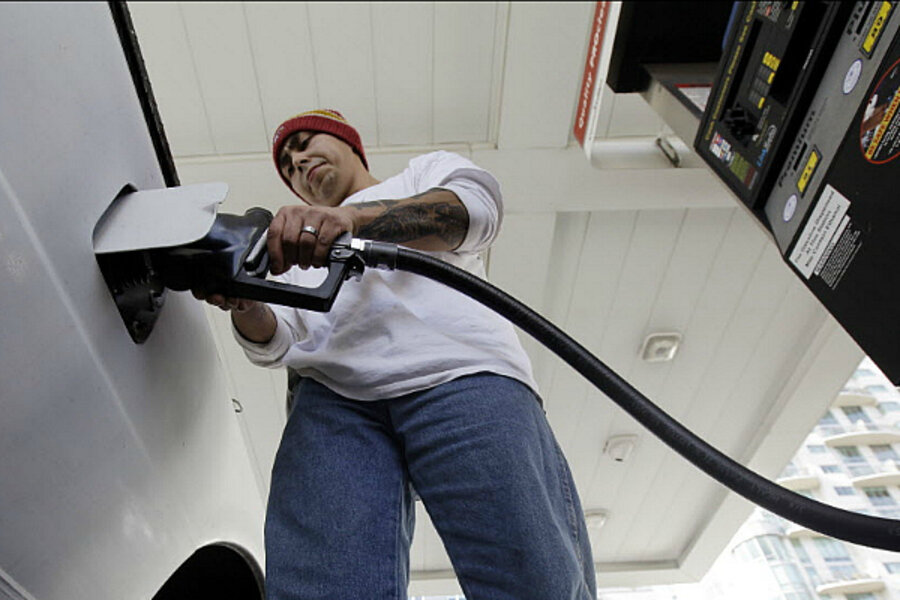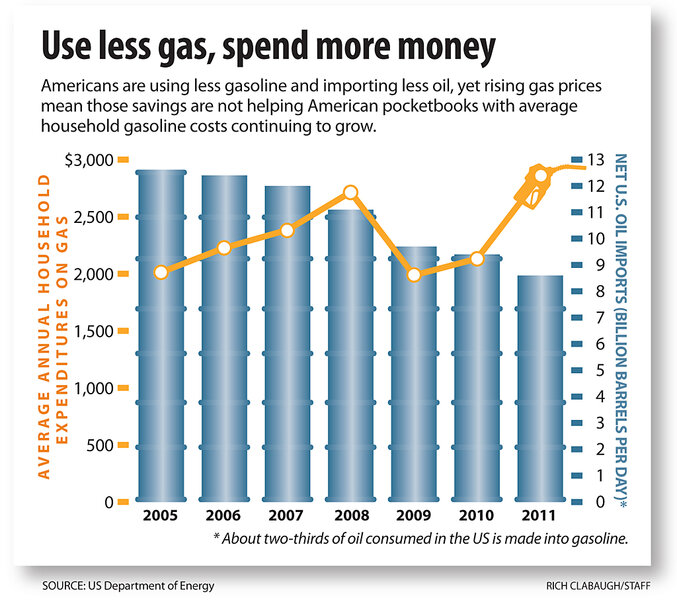Americans' trend line on gasoline: Use less, spend more
Loading...
Slowly, America is shifting gears toward a vastly more efficient use of gasoline in automotive transportation.
In recent years, the trends have been largely positive. Oil consumption in the United States – about two-thirds of which goes toward gasoline – has fallen 9 percent since 2005. Fuel economy among new vehicles sold in the US hit an all-time high last month of 23 miles per gallon. The result of these developments, and a boost in domestic production, means oil imports have dropped 31 percent since 2005.
Yet for Americans, using less gasoline has not meant saving more money. In fact, Americans are paying more than ever for gasoline – much more.
It is a contradiction driven by oil prices set on the world markets – as America begins to cut back, the demand in other nations such as China and India is skyrocketing. Add in the inscrutable decisions of OPEC, and you have America spending 65 percent more on gasoline since 2005 despite its leaner ways.
With part of the downturn in US demand connected to the weak economy, there is concern that the problem could grow worse when the economy eventually recovers and demand rebounds. Indeed, the current dynamic of less demand, higher cost, is throwing into doubt the accepted wisdom that improvements in auto fuel efficiency will put money back in consumers' pockets, some analysts say. The only way out of this vicious cycle, they add, might be out of oil altogether – a solution that is, at best, years away.
"Last year, Americans paid more for gasoline than in any other year before," said Gal Luft, executive director of the Institute for the Analysis of Global Security, a Washington energy-security think tank, in congressional testimony in December. "In other words, we became more self-sufficient and more fuel efficient and at the same time we became poorer and deeper in debt."
Great strides for consumers
In a survey last year, 84 percent of middle-class families polled on behalf of the Consumer Federation of America (CFA) expressed "great concern" about gas prices, with 70 percent favoring new fuel-economy standards.
By most measures, America is making big – if not historic – strides toward this goal. New vehicle fleet fuel economy has improved 14 percent in just four years – helping driving total gas consumption down, Michael Sivak, director of the University of Michigan's Sustainable Worldwide Transportation project, writes in an e-mail.
Americans used 2.8 percent less gasoline last year compared with 2010 – a combination of the weak economy, an aging US population taking shorter trips, and greater fuel efficiency, the US Energy Information Administration (EIA) reported Feb. 8.
In the most recent round of federal mileage standards, effective this year, carmakers must produce a fleet that gets about 34 miles per gallon on average by 2016. But the next round of federal requirements now being considered could mandate an average fleet mileage of 54.5 miles per gallon by 2025.
That would mean a major reduction in US gasoline usage and big savings, the CFA and other consumer groups say. The nation would cut oil consumption and imports by almost 4 billion barrels, the CFA estimates.
But "by far the single largest benefit of '54.5 by 2025' is the reduction of consumer expenditures on gasoline," Mark Cooper, research director for CFA, writes in an analysis. "Consumer pocketbook savings for the typical consumer with a five-year auto loan will be immediate and substantial."
CFA calculates that consumer savings would average nearly $800 by the end of a typical auto loan and $3,000 by the 10th year of ownership – covering the cost of any rise in sales price.
The trends of falling consumption and rising prices, however, have some analysts challenging such figures. Pump prices for regular gasoline are expected to average $3.55 per gallon this year, rising as high as $4 a gallon during the driving season – despite weak demand, the EIA reports.
It is far from clear that mileage standards alone will do anything to prevent price shocks to consumers and the economy, says Mr. Luft of the Institute for the Analysis of Global Security in an interview.
Others agree.
"Dieting isn't going to get us out of this problem," says Anne Korin, chairman of the Set America Free group, a coalition of environmentalists, labor, and national energy-security hawks. "We have a market dominated by a cartel, so it can simply throttle down its supply to keep global supplies tight and the price up."
'Plug-ins' and alt fuels
Unlike in past years, automakers now are promising some vehicles that could begin to change this equation. They will sell in the US this year 13 new "plug-in" vehicles that run partly or entirely on electricity produced with domestic energy.
But plug-ins won't reshape the US auto market overnight. After more than a decade, even standard gas-electric hybrids like the Toyota Prius make up only 1.2 million of the more than 250 million vehicles in the US auto fleet.
What Americans really need is a far broader choice of fuels that includes not just electricity but cellulosic ethanol made from switch grass and methanol made from coal and wood products, Ms. Korin says. Such "fuel competition" made possible by a federal "open fuels standard" would give US motorists a real choice when gasoline prices soar – and lead to real dollar savings, not just a reduction in gasoline use.
For less than $100 per vehicle, automakers could insert stainless steel parts that could allow vehicles to burn ethanol and methanol as well as other fuels, she and others say. "Until we break oil's monopoly over transportation fuel, we are on a playing field where we can never prevail," Korin says.






